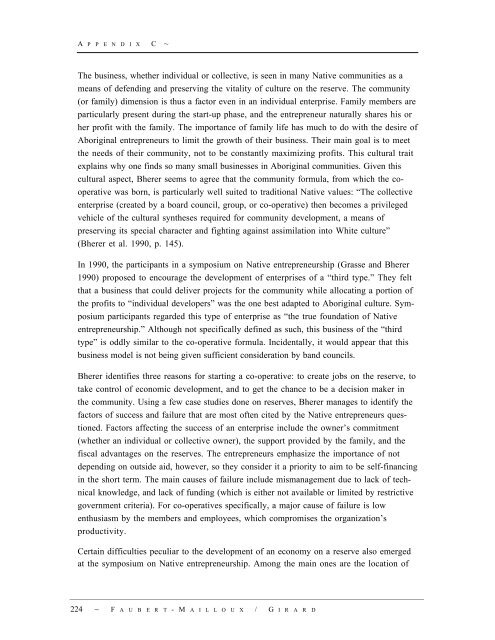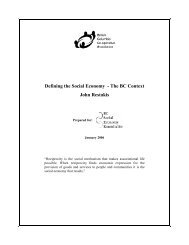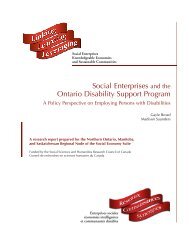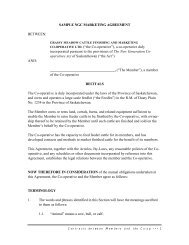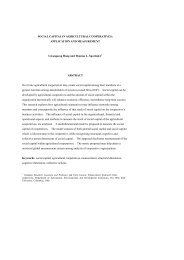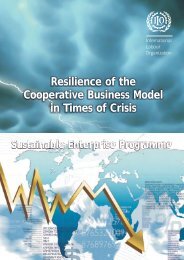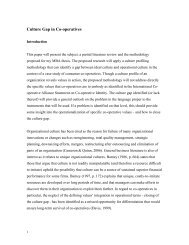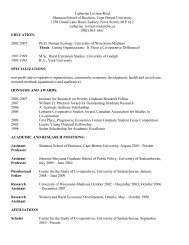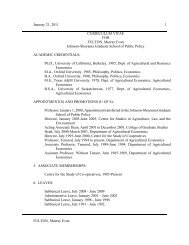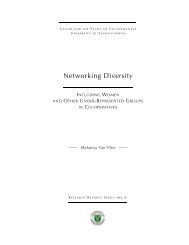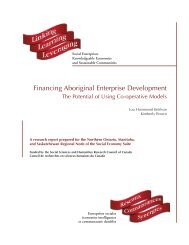Aboriginal Co-operatives in Canada - Centre for the Study of Co ...
Aboriginal Co-operatives in Canada - Centre for the Study of Co ...
Aboriginal Co-operatives in Canada - Centre for the Study of Co ...
Create successful ePaper yourself
Turn your PDF publications into a flip-book with our unique Google optimized e-Paper software.
A P P E N D I X C ~The bus<strong>in</strong>ess, whe<strong>the</strong>r <strong>in</strong>dividual or collective, is seen <strong>in</strong> many Native communities as ameans <strong>of</strong> defend<strong>in</strong>g and preserv<strong>in</strong>g <strong>the</strong> vitality <strong>of</strong> culture on <strong>the</strong> reserve. The community(or family) dimension is thus a factor even <strong>in</strong> an <strong>in</strong>dividual enterprise. Family members areparticularly present dur<strong>in</strong>g <strong>the</strong> start-up phase, and <strong>the</strong> entrepreneur naturally shares his orher pr<strong>of</strong>it with <strong>the</strong> family. The importance <strong>of</strong> family life has much to do with <strong>the</strong> desire <strong>of</strong><strong>Aborig<strong>in</strong>al</strong> entrepreneurs to limit <strong>the</strong> growth <strong>of</strong> <strong>the</strong>ir bus<strong>in</strong>ess. Their ma<strong>in</strong> goal is to meet<strong>the</strong> needs <strong>of</strong> <strong>the</strong>ir community, not to be constantly maximiz<strong>in</strong>g pr<strong>of</strong>its. This cultural traitexpla<strong>in</strong>s why one f<strong>in</strong>ds so many small bus<strong>in</strong>esses <strong>in</strong> <strong>Aborig<strong>in</strong>al</strong> communities. Given thiscultural aspect, Bherer seems to agree that <strong>the</strong> community <strong>for</strong>mula, from which <strong>the</strong> cooperativewas born, is particularly well suited to traditional Native values: “The collectiveenterprise (created by a board council, group, or co-operative) <strong>the</strong>n becomes a privilegedvehicle <strong>of</strong> <strong>the</strong> cultural syn<strong>the</strong>ses required <strong>for</strong> community development, a means <strong>of</strong>preserv<strong>in</strong>g its special character and fight<strong>in</strong>g aga<strong>in</strong>st assimilation <strong>in</strong>to White culture”(Bherer et al. 1990, p. 145).In 1990, <strong>the</strong> participants <strong>in</strong> a symposium on Native entrepreneurship (Grasse and Bherer1990) proposed to encourage <strong>the</strong> development <strong>of</strong> enterprises <strong>of</strong> a “third type.” They feltthat a bus<strong>in</strong>ess that could deliver projects <strong>for</strong> <strong>the</strong> community while allocat<strong>in</strong>g a portion <strong>of</strong><strong>the</strong> pr<strong>of</strong>its to “<strong>in</strong>dividual developers” was <strong>the</strong> one best adapted to <strong>Aborig<strong>in</strong>al</strong> culture. Symposiumparticipants regarded this type <strong>of</strong> enterprise as “<strong>the</strong> true foundation <strong>of</strong> Nativeentrepreneurship.” Although not specifically def<strong>in</strong>ed as such, this bus<strong>in</strong>ess <strong>of</strong> <strong>the</strong> “thirdtype” is oddly similar to <strong>the</strong> co-operative <strong>for</strong>mula. Incidentally, it would appear that thisbus<strong>in</strong>ess model is not be<strong>in</strong>g given sufficient consideration by band councils.Bherer identifies three reasons <strong>for</strong> start<strong>in</strong>g a co-operative: to create jobs on <strong>the</strong> reserve, totake control <strong>of</strong> economic development, and to get <strong>the</strong> chance to be a decision maker <strong>in</strong><strong>the</strong> community. Us<strong>in</strong>g a few case studies done on reserves, Bherer manages to identify <strong>the</strong>factors <strong>of</strong> success and failure that are most <strong>of</strong>ten cited by <strong>the</strong> Native entrepreneurs questioned.Factors affect<strong>in</strong>g <strong>the</strong> success <strong>of</strong> an enterprise <strong>in</strong>clude <strong>the</strong> owner’s commitment(whe<strong>the</strong>r an <strong>in</strong>dividual or collective owner), <strong>the</strong> support provided by <strong>the</strong> family, and <strong>the</strong>fiscal advantages on <strong>the</strong> reserves. The entrepreneurs emphasize <strong>the</strong> importance <strong>of</strong> notdepend<strong>in</strong>g on outside aid, however, so <strong>the</strong>y consider it a priority to aim to be self-f<strong>in</strong>anc<strong>in</strong>g<strong>in</strong> <strong>the</strong> short term. The ma<strong>in</strong> causes <strong>of</strong> failure <strong>in</strong>clude mismanagement due to lack <strong>of</strong> technicalknowledge, and lack <strong>of</strong> fund<strong>in</strong>g (which is ei<strong>the</strong>r not available or limited by restrictivegovernment criteria). For co-<strong>operatives</strong> specifically, a major cause <strong>of</strong> failure is lowenthusiasm by <strong>the</strong> members and employees, which compromises <strong>the</strong> organization’sproductivity.Certa<strong>in</strong> difficulties peculiar to <strong>the</strong> development <strong>of</strong> an economy on a reserve also emergedat <strong>the</strong> symposium on Native entrepreneurship. Among <strong>the</strong> ma<strong>in</strong> ones are <strong>the</strong> location <strong>of</strong>224 ~ F A U B E R T - M A I L L O U X / G I R A R D


